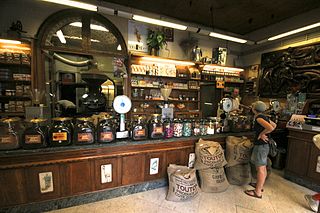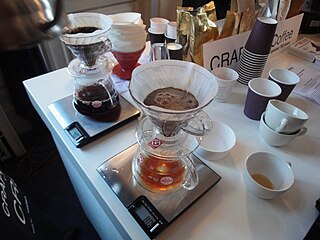
Ethiopian cuisine characteristically consists of vegetable and often very spicy meat dishes. This is usually in the form of wat, a thick stew, served on top of injera, a large sourdough flatbread, which is about 50 centimeters in diameter and made out of fermented teff flour. Ethiopians usually eat with their right hands, using pieces of injera to pick up bites of entrées and side dishes.

Italians are well known for their special attention to the preparation, the selection of the blends, and the use of accessories when creating many types of coffees. Many of the types of coffee preparation known today also have their roots here. The main coffee port in Italy is Trieste where there is also a lot of coffee processing industry. Italian coffee consumption, often espresso, is highest in the city of Trieste, with an average of 1500 cups of coffee per person per year. That is about twice as much as is usually drunk in Italy.

Drip coffee is made by pouring hot water onto ground coffee beans, allowing it to brew. There are several methods for doing this, including using a filter. Terms used for the resulting coffee often reflect the method used, such as drip-brewed coffee, or, somewhat inaccurately, filtered coffee in general. Manually brewed drip coffee is typically referred to as pour-over coffee. Water seeps through the ground coffee, absorbing its constituent chemical compounds, and then passes through a filter. The used coffee grounds are retained in the filter, while the brewed coffee is collected in a vessel such as a carafe or pot.

Turkish coffee is a style of coffee prepared in a cezve using very finely ground coffee beans without filtering.

Coffee is a beverage brewed from roasted coffee beans. Darkly colored, bitter, and slightly acidic, coffee has a stimulating effect on humans, primarily due to its caffeine content. It has the highest sales in the world market for hot drinks.

Maghrebi mint tea, also known as Moroccan mint tea and Algerian mint tea, is a North African preparation of gunpowder green tea with spearmint leaves and sugar.

Eritrean cuisine is based on Eritrea's native culinary traditions, but also arises from social interchanges with other regions. The local cuisine, despite featuring influences of both the Ottoman and Italian cuisines, shares similarities with the cuisine of neighboring Ethiopia and the cuisines from other African countries in the region.
ISO 3103 is a standard published by the International Organization for Standardization, specifying a standardized method for brewing tea, possibly sampled by the standardized methods described in ISO 1839. It was originally laid down in 1980 as BS 6008:1980 by the British Standards Institution, and a revision was published in December, 2019 as ISO/NP 3103. It was produced by ISO Technical Committee 34, Sub-Committee 8 (Tea).

A kopitiam or kopi tiam is a type of coffee shop mostly found in parts of Indonesia, Malaysia, Singapore, Brunei and Southern Thailand patronised for meals and beverages, and traditionally operated by the Chinese community of these countries. The word kopi is an Indonesian and Malay term for coffee and tiam is the Hokkien/Hakka term for shop. Traditional kopitiam menus typically feature simple offerings: a variety of foods based on egg, toast, kaya, plus coffee, tea, Horlicks and Milo. Modern kopitiams typically feature multiple food stalls that offer a wider range of foods.

A cezve, also ibriki/briki, srjep is a small long-handled pot with a pouring lip designed specifically to make Turkish coffee. It is traditionally made of brass or copper, occasionally also silver or gold. In more recent times cezveler are also made from stainless steel, aluminium, or ceramics.

Arabic coffee is a version of the brewed coffee of Coffea arabica beans. Most Arab countries throughout the Middle East have developed distinct methods for brewing and preparing coffee. Cardamom is an often-added spice, but it can alternatively be served plain or with sugar.

Coffee preparation is the process of turning coffee beans into liquid coffee. While the particular steps vary with the type of coffee and with the raw materials, the process includes four basic steps: raw coffee beans must be roasted, the roasted coffee beans must then be ground, and the ground coffee must then be mixed with hot or cold water for a specific time (brewed), the liquid coffee extraction must be separated from the used grounds, and finally, if desired, the extracted coffee is combined with other elements of the desired beverage, such as sweeteners, dairy products, dairy alternatives, or toppings.

The culture of Eritrea is the collective cultural heritage of the various populations native to Eritrea. Eritrea has nine recognized ethnic groups. Each group have their own unique traditions and customs but some traditions are shared and appreciated among different ethnic groups. The local culture consists of various, and often quite similar, traditions practiced by the nation's many Cushitic and Ethiopian Semitic-speaking Afro-Asiatic ethnic groups, in addition to those practiced by the area's Nilotic minorities. Eritrean culture is in some ways similar to the cultures of other countries in the region.

The moka pot is a stove-top or electric coffee maker that brews coffee by passing hot water driven by vapor pressure through ground coffee. Named after the Yemeni city of Mocha, it was invented by Italian engineer Luigi Di Ponti in 1933 who sold the patent to Alfonso Bialetti, an aluminum vendor. It quickly became one of the staples of Italian culture. Bialetti Industries continues to produce the original model under the trade name "Moka Express".

Jebena is a traditional Ethiopian and Eritrean flask made of pottery and used to brew Arabic coffee. It is also widely used in Sudan, and the coffee itself is called bunna.

Sudanese cuisine is greatly affected by the historical cross-cultural influences of Arab, Nubian, Egyptian, Turkish, and Levantine cuisine in Sudan. Many Sudanese foods have been around for thousands of years. The most common meats eaten are lamb and chicken, in accordance with the Muslim halal laws. Most meals are communal and often shared with family, neighbors, and guests, as part of Sudanese hospitality.

A coffeemaker, coffee maker or coffee machine is a cooking appliance used to brew coffee. While there are many different types of coffeemakers, the two most common brewing principles use gravity or pressure to move hot water through coffee grounds. In the most common devices, coffee grounds are placed into a paper or metal filter inside a funnel, which is set over a glass or ceramic coffee pot, a cooking pot in the kettle family. Cold water is poured into a separate chamber, which is then boiled and directed into the funnel and allowed to drip through the grounds under gravity. This is also called automatic drip-brew. Coffee makers that use pressure to force water through the coffee grounds are called espresso makers, and they produce espresso coffee.















